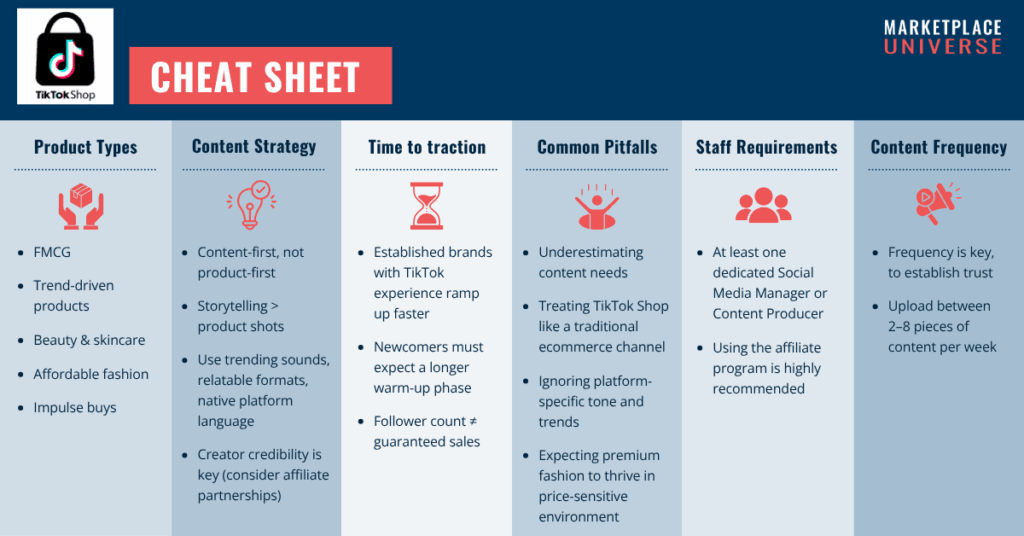
Realtalk: How to make it on TikTok Shop
Written by Ricarda Eichler, Journalist and Author for OHN
Since its launch in Germany in February 2025, TikTok Shop has sparked curiosity, experimentation, and plenty of confusion among brands. The promise is tempting: seamless in-app shopping, high organic reach, and a new generation of consumers ready to buy where they scroll. But behind the hype lies a key question for any brand team: What kind of resources does it actually take to succeed on TikTok Shop?
This article takes a closer look at the operational reality behind the platform. We analyzed the first movers from Germany and how much content they published in order to get their message and products out there. From cosmetics to candy, if your brand is considering TikTok Shop, this piece gives you the numbers you need to decide whether it’s worth the investment.
And don’t forget to check out our ready-to-go TikTok Shop Cheat Sheet below!
Understanding Social Commerce
Before we dive deeper, it is crucial to consider whether Social Commerce is something that even fits your brand. TikTok Shop is not an ecommerce platform and does not intend to become one. It is a content-first, entertainment-driven environment where commerce happens as a byproduct of engagement, not the other way around.
Success on TikTok Shop relies less on traditional product detail pages and more on the ability to spark interest through storytelling, creator credibility, and algorithmic reach. For brands, this means thinking like media producers: understanding trends, moving fast, and creating content that doesn’t just show a product but sells a feeling, a transformation, or a moment.
If your brand is used to polished brand campaigns and slow approval cycles, adapting to this pace and style might require a structural mindset shift. Another way is to seek the external help of a dedicated media agency that helps with content as well as finding fitting creators to join the mission, for example through TikTok’s built-in affiliate program, which allows them to promote your products and earn commission on sales.
On the product side, the success from other markets made it clear, that TikTok Shop is made for FMCG brands. Anything that customers will buy on an impulse can be sold by creating that impulse via storytelling. High-end or technical products will need longer explanations. Too long for the attention span of most users.
How long until the revenue drops?
The amount of time needed to succeed on TikTok Shop vastly depends on whether you have already used the platform before or not. A brand that starts with a million followers already and knows the content drill will be quicker to make sales on TikTok Shop, than one that needs to gain traction first. But being there alone does not guarantee success, which is underscored by the example of About You. Despite having 1.2 million followers on TikTok and being one of the first German brands to join TikTok Shop, they exited the program after just four weeks.
Their follower count alone wasn’t enough to generate meaningful traction or sales. This highlights a key point: success on TikTok Shop isn’t just about presence or audience size – it’s about activating that audience with the right content, offer, and structure behind the scenes. Brands that treat TikTok Shop as just another sales channel, without adapting to its unique dynamics, risk quick burnout or disappointment.
What many brands fail to recognize is that TikTok Shop is designed to attract sellers quickly – then filter them aggressively. The experience of About You may not have been an exception, but rather a predictable outcome of how TikTok structures its merchant journey. As Dutch e-commerce analyst Ed Sander outlined in his K5 China Update, TikTok Shop follows a clearly phased approach that creates early momentum, but demands rapid adaptation and performance if a brand wants to stay visible.
Listen to Ed’s fascinating view on TikTok Shop and how it falls behind its own expectations in Europe in our podcast “Let’s talk Marketplace!
Case Studies: Learn from the First Movers
Beauty brand Cosnova was among the earliest adopters of TikTok Shop in Germany. Known for their presence in drugstores like Rossmann and DM, they didn’t even run a domestic e-commerce store. But they did have a strong TikTok presence. With their in-house content studio, studio_c, launched in 2022, Cosnova produces over 10,000 pieces of content annually. This shift from product-first to content-first allowed them to hit the ground running on TikTok Shop, leveraging both their established community and international learnings. Since launch, they’ve published roughly 228 pieces – around 9 per week – and created viral buzz around products like their cranberry lip oil, which sold out within minutes.
In contrast, Annemarie Börlind entered TikTok in early 2025 specifically to prepare for the Shop launch. They took a curated approach, listing just 20 out of 400 SKUs – items that already had traction with creators. With an average of 3.4 posts per week and a heavy reliance on affiliate marketing (starting with over 1,000 partners), they are now refining their network based on brand alignment and performance.
The fashion segment tells a different story. OACE, a sportswear brand with a strong social media origin, exited TikTok Shop after just a few months. Despite launching with fanfare at OMR and generating solid content output, Co-Founder Jan Kraume cited the platform’s low-price competition as a poor fit for premium positioning.
On the other hand, Teveo, another German sportswear brand, seems more at home in the TikTok Shop ecosystem. Founded in 2019 and active on TikTok since 2021, Teveo blends fitness content with apparel sales and leans heavily on affiliates. With 140,000 followers and a consistent posting rhythm of 5.5 videos per week, the brand represents a content-native, creator-driven model that aligns well with TikTok’s fast-paced environment.
The Bottom Line? Think Like TikTok
TikTok Shop offers a powerful opportunity – but only for those willing to play by its rules. Success on the platform demands more than just presence; it requires speed, creativity, consistency, and a willingness to embrace the chaos of content culture. Brands that thrive treat TikTok not as a sales tool, but as a stage for storytelling – backed by smart creator partnerships, agile content production, and a product offering built for impulse buys.
For brands willing to approach TikTok as a media environment rather than a traditional sales channel, the potential is real. But without the right structure, even strong brands may struggle to gain visibility – or sustain it.
Here’s our cheat sheet for your success on TikTok Shop:
